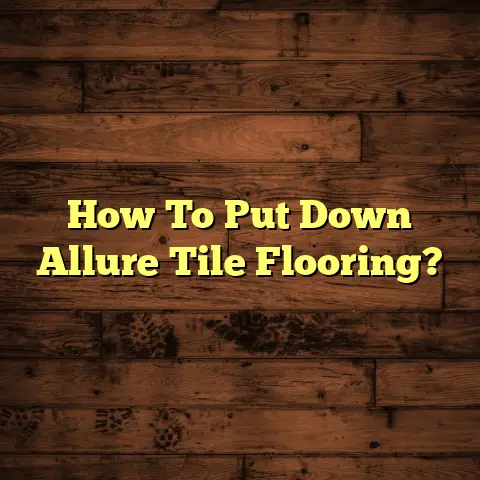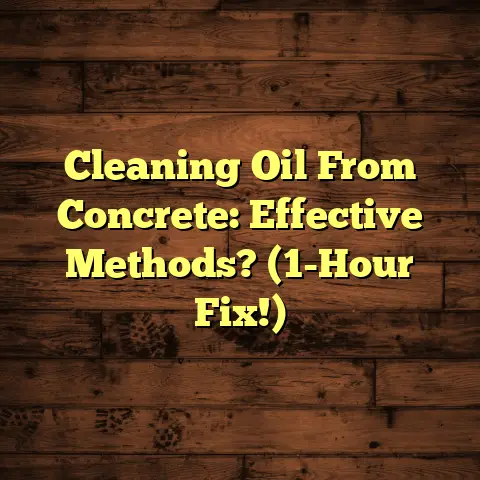Pressure Wash Garage Floor? (2 Pro Secrets)
I’m a flooring contractor, and I’ve seen it all when it comes to garage floors.
Let’s talk about something crucial: future-proofing.
Think of your garage floor as an investment.
A well-maintained floor isn’t just about looks.
It’s about the health and longevity of your entire home.
It boosts functionality and, yes, even aesthetics.
And guess what?
Pressure washing is a HUGE part of keeping that floor pristine and durable.
I’m going to share two pro secrets that will transform the way you think about garage floor maintenance.
Ready to dive in?
Section 1: Understanding the Importance of Pressure Washing Garage Floors
Subsection 1.1: The Benefits of a Clean Garage Floor
Why bother keeping your garage floor clean?
I get it. It’s a garage, right?
But trust me, a clean floor is more important than you think.
First off, it prevents damage.
Grime, oil, and road salt can eat away at your flooring material over time.
A clean floor also improves safety.
Think about it: oil spills are slip hazards waiting to happen.
A clean surface reduces those risks dramatically.
And let’s not forget about the environment.
A tidy garage is just a more pleasant space to work in.
And hey, if you ever decide to sell, a clean garage floor shows that you care about your home.
It preserves the value, plain and simple.
I’ve seen homes sell faster and for more money just because the garage was spotless.
Subsection 1.2: Common Types of Garage Floors
What kind of floor are we talking about here?
Concrete is the most common, of course.
But epoxy and tiles are also popular choices.
Each material has its own set of benefits, and each benefits from pressure washing.
Concrete is tough, but it’s porous.
That means it soaks up stains like a sponge.
Pressure washing blasts away those stains and helps prevent future ones.
Epoxy floors look great, but they can get slippery when dirty.
Pressure washing restores their grip and keeps them looking shiny.
Tiles are durable and easy to clean, but the grout lines can get grimy.
Pressure washing gets into those nooks and crannies, leaving your tiles sparkling.
No matter what type of flooring you have, pressure washing is a key part of maintaining its appearance and integrity.
Section 2: Preparing for Pressure Washing
Subsection 2.1: Assessing Your Garage Floor
Before you even think about firing up that pressure washer, take a good look at your garage floor.
What’s the overall condition?
Are there any existing cracks or damage?
Identifying these issues beforehand is crucial.
It helps you avoid making them worse during the cleaning process.
Look for stains. Oil stains, paint spills, rust spots.
These will need special attention.
Check for cracks. Small cracks can become big cracks if you blast them with high pressure.
Note any areas of wear. Some spots might be thinner or more worn than others.
I usually use a flashlight and get down on my hands and knees for a thorough inspection.
It might seem like overkill, but it’s worth it.
You’ll know exactly what you’re dealing with and can adjust your approach accordingly.
Subsection 2.2: Choosing the Right Equipment
Okay, let’s talk tools.
You’ll need a pressure washer, obviously.
But which one?
Electric pressure washers are great for smaller jobs.
They’re quieter, lighter, and easier to store.
Gas pressure washers are more powerful and better for larger areas or stubborn stains.
I personally prefer gas pressure washers for garage floors because they get the job done faster.
But an electric one will work just fine if that’s what you have.
You’ll also need the right nozzles.
A wide-angle nozzle is good for general cleaning.
A narrow-angle nozzle is for tough stains.
I also recommend a surface cleaner.
These attachments are designed specifically for cleaning floors.
They make the job much faster and more efficient.
And don’t forget the cleaning solutions!
There are tons of detergents designed for pressure washing garage floors.
I usually use a degreaser to tackle oil stains and a general-purpose cleaner for everything else.
Section 3: Pro Secret #1 – The Right Technique for Pressure Washing
Alright, here’s the first pro secret.
It’s all about technique.
You can have the best equipment in the world, but if you don’t use it properly, you’re not going to get the results you want.
Subsection 3.1: Pressure Settings and Angles
The first thing you need to do is adjust your pressure settings.
Too much pressure can damage your floor.
Too little pressure won’t get it clean.
Concrete can handle higher pressure than epoxy or tile.
I usually start with a lower pressure setting and gradually increase it until I find the sweet spot.
The angle of the nozzle is also important.
Hold the nozzle at a slight angle to the surface.
This helps to lift the dirt and grime without damaging the floor.
And keep the nozzle moving!
Don’t hold it in one spot for too long, or you could etch the surface.
I’ve seen people ruin their floors by using too much pressure or holding the nozzle too close.
It’s a common mistake, but it’s easily avoided if you pay attention.
Subsection 3.2: Effective Cleaning Patterns
Now, let’s talk about cleaning patterns.
Don’t just randomly spray the floor and hope for the best.
Use a systematic approach.
I like to start in one corner and work my way across the floor in straight lines.
Overlap each line slightly to ensure complete coverage.
You can also use a zig-zag pattern.
This is especially effective for large areas.
For tough stains, pretreat them with a cleaning solution and let it sit for a few minutes.
Then, use a narrow-angle nozzle to blast away the stain.
Work in small sections and rinse frequently.
I often use a stiff brush to scrub the floor while I’m pressure washing.
This helps to loosen stubborn dirt and grime.
Section 4: Pro Secret #2 – Post-Washing Care and Maintenance
Okay, you’ve pressure washed your garage floor.
It looks great!
But the job’s not done yet.
Here’s the second pro secret: post-washing care and maintenance.
This is where you really future-proof your floor.
Subsection 4.1: Proper Drying Techniques
Once you’ve finished pressure washing, it’s important to let the floor dry completely.
This can take several hours, depending on the humidity and temperature.
Don’t park your car on the floor until it’s completely dry.
This can trap moisture and cause stains.
I like to use fans to speed up the drying process.
Open the garage door and windows to increase ventilation.
You can also use a squeegee to remove excess water.
Make sure the floor is completely dry before you apply any sealants or coatings.
Subsection 4.2: Protective Measures Following Cleaning
Now, for the final step: applying a sealant or coating.
This will protect your floor from future stains and damage.
There are tons of products on the market.
Epoxy coatings are popular because they’re durable and look great.
But they can be expensive and difficult to apply.
Acrylic sealants are a more affordable and easier-to-apply option.
They provide good protection against stains and water damage.
I recommend applying a sealant or coating every year or two.
This will keep your garage floor looking its best for years to come.
Here’s a table with examples of sealant and coating options:
| Type | Pros | Cons | Typical Cost (per sq ft) |
|---|---|---|---|
| Acrylic Sealant | Affordable, Easy to apply, Good stain protection | Less durable than epoxy, Needs frequent reapplication | $0.50 – $1.50 |
| Epoxy Coating | Durable, Attractive, Chemical resistant | Expensive, Difficult to apply, Can be slippery when wet | $3.00 – $7.00 |
| Polyurethane Sealant | Excellent abrasion resistance, UV resistant | More expensive than acrylic, Requires professional application for best results | $2.00 – $5.00 |
| Siloxane Sealant | Water repellent, Breathable, Long-lasting | Less effective against oil stains, Can be more costly | $1.00 – $3.00 |
Note: Prices are estimates and can vary depending on location and specific product.
Regular maintenance is also key.
Sweep your garage floor regularly to remove dirt and debris.
Clean up spills immediately to prevent stains.
And pressure wash your floor every year or two to keep it looking its best.
Section 5: Troubleshooting Common Problems
Subsection 5.1: Dealing with Stubborn Stains
Sometimes, pressure washing alone isn’t enough to remove stubborn stains.
Oil stains, rust stains, paint spills.
These can be tough to deal with.
For oil stains, try using a degreaser.
Apply it to the stain and let it sit for a few minutes before pressure washing.
You can also try using a poultice.
Mix baking soda with water to form a paste.
Apply the paste to the stain and let it dry completely.
Then, scrape it off.
For rust stains, try using a rust remover.
Follow the instructions on the label.
For paint spills, try using a paint remover.
Be careful not to damage the underlying floor.
I’ve had success with using a combination of these techniques.
Sometimes, it takes a little elbow grease to get the job done.
Subsection 5.2: When to Seek Professional Help
Okay, let’s be real.
Sometimes, DIY isn’t the best option.
If you’re dealing with extensive damage, or if you’re just not comfortable pressure washing your garage floor yourself, it’s best to call in the pros.
A professional flooring contractor has the experience and equipment to get the job done right.
They can also identify potential problems that you might miss.
And they can save you time and money in the long run.
I’ve seen people try to DIY their garage floor cleaning and end up making things worse.
It’s not worth the risk.
If you’re not sure what you’re doing, call a professional.
Here’s a quick checklist to help you decide if you need professional help:
- Extensive Damage: Large cracks, severe pitting, or crumbling concrete.
- Hazardous Materials: Asbestos or lead paint present.
- Lack of Experience: If you’ve never used a pressure washer before.
- Time Constraints: If you don’t have the time to do it yourself.
- Expensive Flooring: If you have a high-end epoxy or tiled floor.
Conclusion
So, there you have it.
Pressure washing is a crucial part of future-proofing your garage floor.
It keeps it clean, safe, and durable.
And by following these two pro secrets – using the right technique and providing post-washing care – you can keep your garage floor looking its best for years to come.
Remember, it’s not just about cleaning.
It’s about protecting your investment and ensuring the longevity of your home.
So, what are you waiting for?
Get out there and give your garage floor the TLC it deserves!
I hope this article has been helpful.
If you have any questions, feel free to ask in the comments below.
Happy cleaning!





